Peanut Butter Siamese Cat Sandwich Cookies
12111 views| 1 comments
Copyright © 2000 Sarah Phillips CraftyBaking.com All rights reserved.
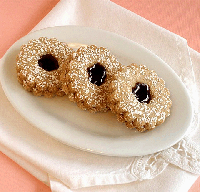 Cookies contain many of the same ingredients as cakes except that they have a lower proportion of liquid with a higher proportion of sugar and fat to flour. COOKIE TYPES are usually categorized by the fluidity of their batter or dough, detemining the way they are formed - Bars, Dropped, Icebox / Refrigerator, Molded, Pressed, or Rolled. In additon, some cookie types are subtypes of others. The type of cookie to be prepared determines their mixing method, but for most, the conventional cake or creaming method is used.
Cookies contain many of the same ingredients as cakes except that they have a lower proportion of liquid with a higher proportion of sugar and fat to flour. COOKIE TYPES are usually categorized by the fluidity of their batter or dough, detemining the way they are formed - Bars, Dropped, Icebox / Refrigerator, Molded, Pressed, or Rolled. In additon, some cookie types are subtypes of others. The type of cookie to be prepared determines their mixing method, but for most, the conventional cake or creaming method is used.
COOKIE DECORATING is popular. And, proper COOKIE STORAGE is important.
THE THREE MAIN INGREDIENTS present in nearly every type of cookie are wheat flour, sugar, and fat, but you'll see other ingredients such as leaveners, eggs, liquids, such as milk, perhaps some chocolate, coconut, spices or nuts. As in all other areas of baking, using fresh, high-quality ingredients is critical to success.
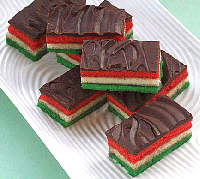 WHEAT FLOUR
WHEAT FLOUR
The type of flour determines the structure of the cookie, and is the main binding agent. Each type of flour has an individual protein profile suitable almost exclusively for specific uses. All-purpose flour is generally used in most cookie recipes, but other wheat flour types are found, as well. The addition or substitutions of other flours, such as bread or cake flour are sometimes added to get different results in a recipe. For example, bread flour can be used instead of all-purpose flour; it can absorb much more liquid because of its higher protein content, more moisture will stay in the cookie and it will be chewier. Replacing a few tablespoons of all-purpose flour with cake flour will give you a tenderer cookie. However, each cookie recipe is different and a successful outcome cannot be determined.
SARAH SAYS: Cake flour is made with soft wheat, so you get less protein (7.5%) in your flour, less gluten in the mixture, and a very tender, potentially puffy, cookie. With bread flour, made from hard wheat, you have an increase in protein (to 12%), an increase in gluten and, therefore, a chewy cookie.
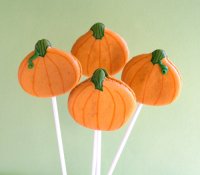 SWEETENERS
SWEETENERS
Some form of sugar is used in all cookie recipes. It is a tenderizing agent, adds sweetness and affects the spread of the cookie. Granulated sugar or brown sugar is used frequently in cookie making, but honey, molasses, corn syrup and other sugars can be used, sometimes in combinations. It can be confusing as to which type to use; when a recipe calls simply for "sugar," it is safe to assume that granulated table sugar is intended.
SARAH SAYS: The type of sugar and how much you use plays a big role in the outcome of the cookie's taste and texture, but the recipe plays the biggest role. Most chocolate chip recipes call for both types of sugar, such as in the Nestle's Chocolate Chip Cookie Recipe, to get the best of both worlds.
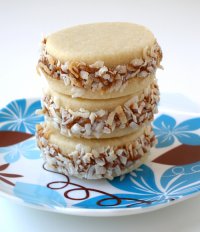 FATS
FATS
such as stick butter and margarine, lard and shortening, all have their place in the cookie world. They coat the flour's gluten strands, some better than others and prevent the cookie from becoming tough when moistened and stirred. I like to use plain, pure (unsalted) butter because I find it adds the best flavor to a cookie recipe, but every baker has their own preference.
SARAH SAYS: Each type of fat used in cookie recipes separately affects the cookie's texture and taste. Generally, the use of butter means flatter, crispier cookies because it allows the dough to spread as it cooks on the hot cookie sheet. Cookies made with shortening will not spread, however all shortening will give you a cookie without a lot of taste. This approach gives you the best of both worlds: shortening is not as sensitive to shifts in temperature and the butter gives a lot of flavor.
EGGS
Use only fresh eggs and they need not be at room temperature. If the recipe is simply written with the word "eggs", use large which have a volume of about 1/4 cup (50 grams) each. The liquid from the egg forms steam and gets trapped in the cookie, puffing it up. In addition, they emulsify the dough, bringing the water and fat phases together in a recipe for a creamier, smoother texture. On the other hand, egg whites have a drying effect and but also contribute to the structure or shape of a cookie.
LIQUIDS
Liquids are essential to cookie recipes, but they typically have very little. When wheat flour is moistened and stirred, gluten is formed from the proteins present. Gluten strands form the structure of the cookie, but they also have a toughening effect. Fats, such as stick butter and shortening, shorten the strands, and give you a tenderer cookie. If you add too much liquid, like milk or water, your cookie dough is going to be like a very thick pancake batter which won't bake like cookie dough.
DAIRY
Unless you are making low-fat or fat-reduced recipes, choose full-fat dairy products. Always use solid cream cheese and not the whipped variety.
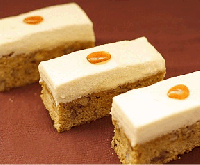 LEAVENERS
LEAVENERS
Baking soda and baking powder are the classic leaveners in cookie recipes, but beaten egg whites can be found, too. Used together and separately, these components affect the puffiness to some degree (baking powder), but they also affect the color of the cookie (baking soda).
FLAVORINGS
Cocoa, nuts, extracts, and other flavorings, all contribute to the character and taste of a cookie. I recommend using only pure vanilla extract, never imitation, even though you can buy quarts of the imitation stuff for the price of one good bottle of pure vanilla -- it keeps forever in a dark and cool storage cabinet. The taste of imitation vanilla is immediately detected, and is exaggerated if the dough or cookies are frozen. Use them discriminatingly but courageously. A touch of almond extract in a plain sugar-cookie recipe (add about 1/2 teaspoon at the same time you add the eggs to the dough), or a good dash of cardamom in spicy applesauce bars (add 1/2 teaspoon cardamom along with the other spices) makes a subtle but significant difference.
OTHERS
Oatmeal means uncooked rolled oats, either old-fashioned or quick, but not instant. Instant will get too mushy in the recipe.
Coconut means the shredded or flaked and sweetened kind. If you have fresh coconut, grate it and soak it in milk, refrigerated, for about 6 hours, then drain. This will give it about the same moisture content as the packaged kind.
Raisins, which may be used interchangeably with chopped dates in most recipes, are the dark Thompson seedless variety, unless golden raisins are specified. Currants and muscat raisins are occasionally used. Raisins should be plump and soft. If they seem dry and hard, soak them in hot water for 15 or 20 minutes, and then drain before using.
Nuts can mean walnuts, pecans, and almonds, plus others. They can become rancid quickly (in just a week or two, depending on conditions) at room temperature, and should be stored in the refrigerator or freezer. When a recipe calls for chopped nuts, it usually means walnuts or pecans. Almonds, with their delicate flavor, and peanuts, which are more assertive, should be used only when specified.
Grated orange and lemon rind (known as "zest") refers to the outer colored portion of the rind.
Chocolate may be specified as unsweetened, sweetened or bittersweet chocolate, semi-sweet (such as the chocolate chips commonly used in Toll House cookies), or sweet. Cocoa (the unsweetened powder, not a mix) is also called for in some recipes. Be sure to use the type of chocolate specified, as substitutions may not be successful. Chocolate burns easily, so the best way to melt it is in a double boiler over hot water, in a microwave oven or in an oven as it preheats for the recipe. Experienced cooks sometimes place chocolate in a heavy saucepan over direct low heat, but that method carries the risk of scorching.
HOW INGREDIENTS IMPACT A COOKIE RECIPE
Understanding cookie chemistry comes in handy -- you can tinker and fool around to your heart's content to get cookies exactly the way you want them. But, always keep in mind, I have found that the recipe pretty much dictates how the cookies are going to turn out. Fiddling with one or two ingredients does change a recipe, but you may not like the results. I have found, 99.99% of the time, for good results, others have to be changed, as well and it takes lots of trial and error.
SARAH SAYS: Use this guide to help you adjust a recipe you've already made so you know what the original was like and what you'd like to change. And be sure to adjust ingredients, baking times and other elements gradually, preferably one or two at a time. You'll find that sometimes simply tweaking something by a tablespoon can make a difference. These tips are from Shirley Corriher's 1997 "Cookwise" (William Morrow, 1997).
High-protein flour: All-purpose flour. Makes cookies darker in color and flatter.
Low-protein flour: Cake flour. Making cookies pale, soft and puffy.
Fat with sharp melting point, like butter: Makes cookies spread.
Fat that maintains same consistency over a wide temperature range, such as solid vegetable shortening: Makes cookies that do not spread as much.
Corn syrup (or molasses): Makes cookies browner.
Brown sugar and honey: Makes cookies that soften the longer you keep them.
You want the cookies to spread more: Use all butter OR add 1 to 2 tablespoons liquid (water, milk or cream -- not egg) OR use BLEACHED all-purpose (but not one that is chlorinated) OR add 1 to 2 tablespoons sugar.
You want the cookies to spread less: Use solid vegetable shortening or substitute some solid vegetable shortening for an equal amount of butter OR use cake flour OR cut the sugar by a few tablespoons OR switch from baking soda to baking powder OR chill the dough before baking it.
You want the cookies to have a chewy quality: Melt the butter instead of simply using it at room temperature.
You want the cookies to have a cakey quality: Use the butter at room temperature or use equal parts butter and solid vegetable shortening.
You want the cookies to be tenderer: Use cake flour OR add a few tablespoons of sugar OR add a few tablespoons of fat.
The cookies are too tender and you want them to be more substantial: Substitute a few tablespoons of bread flour for an equal amount of all-purpose flour OR cut the sugar by a few tablespoons OR cut the fat by a few tablespoons
You want the cookies to brown better: Substitute 1 to 2 tablespoons of light corn syrup for an equal amount of sugar OR substitute a few tablespoons of unbleached or bread flour for equal amounts of the all-purpose flour.
The cookies are browning too much, despite the correct oven temperature: Substitute water for an equal amount of liquid ingredients OR use cake flour or bleached all-purpose flour.
12111 views| 1 comments
8866 views| 4 comments
8172 views| 1 comments